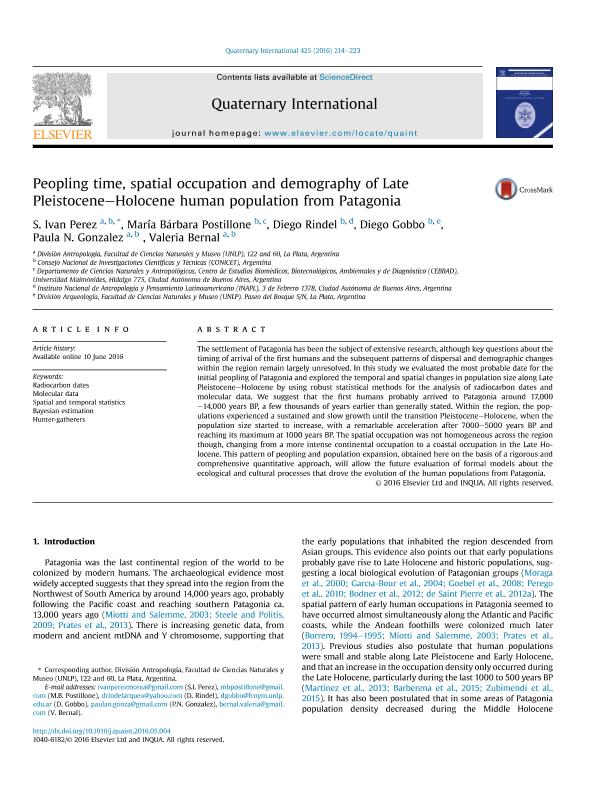Artículo
Peopling time, spatial occupation and demography of Late Pleistocene–Holocene human population from Patagonia
Perez, Sergio Ivan ; Postillone, María Bárbara
; Postillone, María Bárbara ; Rindel, Diego Damián
; Rindel, Diego Damián ; Gobbo, Juan Diego
; Gobbo, Juan Diego ; Gonzalez, Paula Natalia
; Gonzalez, Paula Natalia ; Bernal, Valeria
; Bernal, Valeria
 ; Postillone, María Bárbara
; Postillone, María Bárbara ; Rindel, Diego Damián
; Rindel, Diego Damián ; Gobbo, Juan Diego
; Gobbo, Juan Diego ; Gonzalez, Paula Natalia
; Gonzalez, Paula Natalia ; Bernal, Valeria
; Bernal, Valeria
Fecha de publicación:
12/2016
Editorial:
Pergamon-Elsevier Science Ltd
Revista:
Quaternary International
ISSN:
1040-6182
Idioma:
Inglés
Tipo de recurso:
Artículo publicado
Clasificación temática:
Resumen
The settlement of Patagonia has been the subject of extensive research, although key questions about the timing of arrival of the first humans and the subsequent patterns of dispersal and demographic changes within the region remain largely unresolved. In this study we evaluated the most probable date for the initial peopling of Patagonia and explored the temporal and spatial changes in population size along Late Pleistocene–Holocene by using robust statistical methods for the analysis of radiocarbon dates and molecular data. We suggest that the first humans probably arrived to Patagonia around 17,000–14,000 years BP, a few thousands of years earlier than generally stated. Within the region, the populations experienced a sustained and slow growth until the transition Pleistocene–Holocene, when the population size started to increase, with a remarkable acceleration after 7000–5000 years BP and reaching its maximum at 1000 years BP. The spatial occupation was not homogeneous across the region though, changing from a more intense continental occupation to a coastal occupation in the Late Holocene. This pattern of peopling and population expansion, obtained here on the basis of a rigorous and comprehensive quantitative approach, will allow the future evaluation of formal models about the ecological and cultural processes that drove the evolution of the human populations from Patagonia.
Archivos asociados
Licencia
Identificadores
Colecciones
Articulos(CCT - LA PLATA)
Articulos de CTRO.CIENTIFICO TECNOL.CONICET - LA PLATA
Articulos de CTRO.CIENTIFICO TECNOL.CONICET - LA PLATA
Articulos(SEDE CENTRAL)
Articulos de SEDE CENTRAL
Articulos de SEDE CENTRAL
Citación
Perez, Sergio Ivan; Postillone, María Bárbara; Rindel, Diego Damián; Gobbo, Juan Diego; Gonzalez, Paula Natalia; et al.; Peopling time, spatial occupation and demography of Late Pleistocene–Holocene human population from Patagonia; Pergamon-Elsevier Science Ltd; Quaternary International; 425; 12-2016; 214-223
Compartir
Altmétricas



